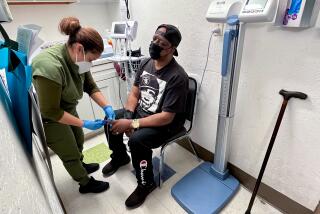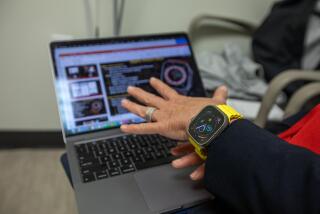War on Hypertension Has Its Ups and Downs
- Share via
Whenever you visit your doctor’s office, you probably have come to expect a blood-pressure check by a nurse before you are seen by your physician. But chances are one in three that these routine blood-pressure readings are wrong, according to a recent UC Irvine study.
UCI researchers have found that a third of the people diagnosed as having high blood pressure don’t actually have it. And an equal percentage with supposedly normal readings were found to have high blood pressure and not know it.
Since one in four Americans--60 million people, according to estimates by the American Heart Assn.--suffer from potentially fatal hypertension (high blood pressure), the study has far-reaching implications, according to lead researcher Dr. Michael Weber, 43, a UCI professor of medicine who is the director of the Long Beach-based Hypertension Center.
Related Diseases
(Hypertension and high blood pressure are used interchangeably by physicians and, according to Weber, the terms mean the same thing: the actual force or pressure of blood within the heart and arteries is too high. In time this can lead to other medical emergencies, such as strokes, heart attacks or kidney disease.)
The UCI study, which looked at the effectiveness of 24-hour monitoring of blood pressure, was published this summer in the American Heart Journal. It used a high-tech monitoring device originally developed to study blood-pressure fluctuations in space shuttle astronauts.
“We have been working with the device since 1978, when (physician-engineer-astronaut) Bill Thornton, who was the first person to wear it in space, came here to the Hypertension Center and finished the final design so that it could be used on patients here on Earth,” Weber said.
The instrument, Pressurometer III, is now manufactured by Del Mar Avionics of Irvine and uses a conventional blood-pressure cuff worn on the arm. It attaches to a four-pound recording device that can be worn on a belt or with a shoulder harness. The device automatically inflates the cuff at regular intervals, taking blood-pressure readings and recording them as the patient carries out his everyday tasks over a 24-hour period.
Subjects ‘Perfectly Matched’
In earlier studies, Weber and his associates had used the device to study hundreds of people with hypertension and more than 80 people with normal blood pressures. However, Weber said this latest study was the first ever conducted in the United States in which patients with high blood pressure and patients with normal blood pressure were studied at the same time using the 24-hour monitoring device. He said the study’s subjects “were perfectly matched” for age, height and weight to remove any variables that might affect blood-pressure readings.
During the study, Weber and his colleagues monitored 29 men who previously had been diagnosed as having hypertension and another 29 male volunteers who previously had been diagnosed as having normal blood pressure. Weber’s research team discovered that nine of the hypertensive patients had fewer than 25% of their readings in the high-blood-pressure range.
On the other hand, an equal number of supposedly healthy men were found to have more than 25% of their readings in the high-blood-pressure range.
If those percentages were extrapolated to the general population, Weber said, it would mean that millions of Americans are needlessly being prescribed anti-hypertensive medications, which sometimes cause negative side effects, such as dizziness, depression and impaired alertness.
“And of course there is the unnecessary expense and inconvenience of taking this medication,” Weber said during a recent interview in his office at the Hypertension Center, a research and treatment facility operated jointly by UCI and the Veterans Administration Medical Center in Long Beach.
Many Not Treated
Equally alarming, Weber said, is that more than 30% of supposedly healthy people may actually suffer from hypertension but are not being treated for the disease, which is a leading cause of heart attacks and strokes in the United States and a major cause of death in people over 50.
Weber said that he and fellow researchers Dr. Jan Drayer, a UCI professor of medicine, and research associate Dina Nakamura found that the 24-hour monitoring procedure overcomes the problems of one-time tests in doctors’ offices because of the continuous recording feature.
“Twenty-four-hour monitoring eliminates the effects of apprehension and stress some patients experience when they are tested in a doctor’s office, causing them to have abnormally high blood-pressure readings,” Weber said.
More important than documenting the failings of the present one-time method of measuring blood pressure, Weber said, is the fact that the UCI study is “going to improve the quality of treatment for high blood pressure.”
‘More Confident Diagnoses’
“Because 24-hour monitoring provides more comprehensive measurement of blood pressure, doctors will feel more confident in their diagnoses,” he said. “Patients with high blood pressure will receive more aggressive treatment than they presently do. Many physicians are too conservative in their treatment regimens for high-blood-pressure patients.”
Notwithstanding the study’s findings, Weber said he doesn’t expect most doctors to immediately adopt the use of 24-hour blood-pressure monitoring devices.
“The Pressurometer has been on the market for less than two years, but the several hundred in use in the U.S. have so far been mainly utilized by (medical) specialists and hypertension researchers like myself,” Weber said.
Echoing this view is V.R. McCall, manager of sales applications for Pressurometer manufacturer Del Mar Avionics. McCall, in a telephone interview from the firm’s headquarters, said that while the device has been on the market for 18 months, the $10,500 to $16,000 cost for the “total package” of device components has resulted in only about 850 being in use throughout the world. He said six Pressurometers are being used by physicians in Orange County and three are being used by their counterparts in Los Angeles County.
Equipment Is Expensive
“At $10,000, the equipment is fairly expensive for the average doctor to buy for his office,” Weber said. “And it’s fairly expensive to use because it requires nurses’ and physicians’ time to place the equipment on the patient properly. Also, it costs upwards of $200 to interpret the data that’s spewed out by the equipment.”
Nonetheless, he thinks that the 24-hour test will become a standard procedure in the next few years. But even then, Weber believes that doctors’ primary use of the test will be to eliminate doubt about borderline hypertension cases.
“If the patient has very severe hypertension, there’s no need for this equipment because it will be picked up by the sphygmomanometer mercury devices used in doctors’ offices today,” he said.
“By the same token, if you have a very low blood pressure, there is no need for this equipment.”
However, Weber thinks that use of the device makes sense economically in other ways. “It costs the patient, typically, $200 to $300 a year for medicine to treat high blood pressure. If it can be proven by using this equipment that the patient in fact doesn’t have high blood pressure, this is an obvious saving.”
Willing to Pay
One physician who hasn’t been deterred by the equipment’s cost is Dr. W. C. McCall, who operates a family practice in Anaheim and has spent $32,000 for two of the units. Nor have his patients balked at paying the $250 cost for 24-hour monitoring, versus the standard $30 fee for an office call and having their blood pressure taken the traditional way. McCall said his patients willingly pay a premium for the “superior and unique” health benefits of round-the-clock monitoring.
“Before I started using 24-hour, ambulatory blood-pressure monitoring, I thought you could take a patient’s blood pressure anytime and it would be the same,” McCall said. “But I’ve found--and studies have been published that bear this out--that over a 24-hour period your blood pressure goes up and down, depending on your exertion, stress on the job, pain or drinking (alcohol).”
In order to determine whether a patient has high blood pressure, McCall tests each patient on three separate occasions using the traditional method. Those patients discovered to have high blood pressure using this method are then placed on the 24-hour ambulatory blood-pressure monitoring device before being prescribed medication.
“What I’ve found fascinating is that 30% of my patients determined to have high blood pressure using the traditional method turn out not to have high blood pressure after all, after they’ve been put on the 24-hour, ambulatory blood-pressure monitoring device,” McCall said. “This prevents these patients from needlessly having to use blood-pressure medication for the rest of their lives.”
‘Sustained Hypertension’
Equally as interesting to McCall is that, using the monitoring device, he has found that only 10% of high-blood-pressure patients have so-called “sustained hypertension,” or elevated blood pressure around the clock.
“The remaining 90% have normal blood pressures at night; they’re generally hard-charging ‘Type A’ people who’re able to unwind at night once they’re away from the stresses of the office,” McCall said.
“Modern treatment of blood pressure calls for the patient to take a pill in the morning and another one at night. But since ambulatory blood-pressure monitoring shows that 90% of these patients don’t have elevated pressures at night, I tell them not to take medication then because it doesn’t do them any good--and it’s a waste of money.”






